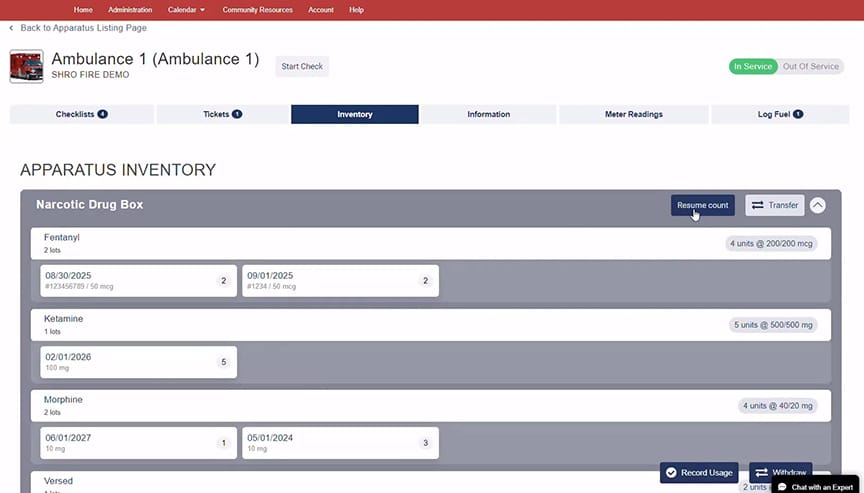February 26, 2024 5 min read

How Controlled Substance Tracking Software Mitigates Risk for EMS Providers
Industry:
Solution:

Whether an EMS provider is administering an opioid to control pain, a benzodiazepine to stop a seizure, or sedative to calm a patient in distress, the use of any controlled substance must be done with care to ensure patient safety. However, the risks associated with controlled substances aren’t limited to just their use. How an agency handles storage, inspection, and destruction of these tightly controlled medications is just as imperative when it comes to mitigating risk.
The landscape of controlled substance management is a complex web of regulations, accountability measures, and ethical considerations. While the vast majority of EMS providers handle these drugs appropriately, the unfortunate reality is that, for a variety of reasons, a provider may be tempted by them. Beyond their use recreationally, controlled substances could be a source of quick cash, be provided to a suffering friend or relative, or even swapped for other black-market substances.
When the source of this temptation is so close at hand, the best way to protect EMS agencies and providers is to implement safeguards that can not only act as a deterrent against giving into temptation and but can also reduce instances of simple human error.
EMS Providers Are At Increased Risk of Substance Abuse
EMS providers operate in a high-pressure environment where split-second decisions can mean the difference between life and death. Whether it be witnessing traumatic events, the constant pressure to perform under extreme conditions, or facing threats to their own life, the cumulative effect of these stressors can be overwhelming.
Research has shown that, like other first responders, EMS providers are at greater risk of developing behavioral health conditions than the general population. According to one study, 69% of EMS professionals did not have enough time to recover between traumatic events. These sorts of exposures, compounded back-to-back and without a proper recovery period in-between, can result in the development of unhealthy coping mechanisms and could lead otherwise law-abiding citizens to attempt desperate measures for relief.
Moreover, the irregular and often unpredictable nature of EMS can disrupt sleep patterns, exacerbating stress and contributing to fatigue. In one study, more than half of surveyed EMS providers were found to be fatigued. Sleep disruption on its own has also been found to be a risk factor for substance abuse, elevating the risk for EMS providers even further.
According to JEMS, signs that an individual may be experiencing substance use disorder include:
- Regularly arriving late to work
- Smelling of alcohol or marijuana
- Physical symptoms like red eyes, sweating, tremors, or fatigue
- Cognitive symptoms such as low concentration or difficultly with comprehension
- Slurred or slowed speech
- Emotional outbursts
- Isolating themselves more than usual
- Evidence of problems in familial or romantic relationships
- Outspoken denial of having an issue
- Continued use of the substance even after expressing remorse, regret or experiencing other negative consequences
Reducing Risk Requires Accountability and Transparency
Implementing comprehensive controlled substance tracking programs is paramount in reducing the risk of misuse and diversion among EMS providers. These programs serve as a critical safeguard for agencies and providers, providing accountability and transparency in the handling and tracking of controlled substances.
“The structured approach that we developed and had in place reduced the opportunity for people to have that substance abuse issue tied directly to their job,” said Chief Matt Shronts, Solutions Engineer at Vector Solutions in a webinar on controlled substance tracking.
By establishing strict protocols and utilizing advanced software systems, EMS agencies can effectively monitor the entire lifecycle of these medications, from procurement to disposal, thereby minimizing the opportunity for unauthorized access or misuse.
Beyond the negative health impacts of substance abuse on providers, agencies also face substantial financial penalties should controlled substances go missing.
“It was always very important that we were in compliance. I didn’t have enough money to pay any of those fines, nor did I want to put myself or the agency in jeopardy. That’s a concern that really did affect me on a daily basis,” said ret. Chief Robbi King, Solutions Engineer at Vector Solutions.
Controlled substance tracking software, like the controlled substance module of Vector Check It, can significantly enhance accountability and oversight. It also offers agency leadership peace of mind that controlled substances are being handled properly on every single call.

With Vector Check It, agencies can streamline record-keeping tasks and minimize the potential for human error or diversions, thereby enhancing the accuracy and reliability of controlled substance tracking.
- Increased Transparency: EMS agencies can see an overview of all medications across all stations at any point in time, including quantities, locations, and expiration dates.
- Improved Records: Providers can easily record drug box counts, usage, transfers, and custody changes to reduce liability and maintain compliance.
- Mitigated Risk of Diversions or Irresponsible Handling: Personal accountability is increased with security features like electronic signatures, PINs, and biometric security options.
- Audit Ready: Filterable audit trails ensure thorough recordkeeping of every controlled substance interaction, including movement, administration, wastage and disposal, and can be exported to provide to overseeing entities as necessary.
Comprehensive controlled substance tracking programs are also essential in minimizing the risks associated with substance abuse, diversions, and human error among EMS providers. By implementing stringent protocols, utilizing advanced software systems, and conducting regular audits, agencies can enhance accountability, transparency, and safeguard EMS providers’ careers.
Vector Solutions’ suite of industry-leading software solutions for EMS departments includes training management systems, online training courses, live skill evaluations, operational management solutions, and an early intervention and performance management system.
To learn more about how Vector Solutions can help your agency manage and reduce risk related to controlled substances, request a demo today.







